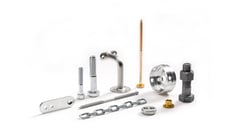- Insights
- The Solutionists Hub
- Vendor Managed Inventory: The Benefits of VMI for C-Parts Purchasers
Vendor Managed Inventory: The Benefits of VMI for C-Parts Purchasers

Vendor managed inventory (VMI) solutions are popular among manufacturing companies that have a large number of different C-parts in their inventory. With a solution like this, the supplier of the parts takes over some or all of the responsibility for ordering, managing and replenishment in the parts store.
For purchasers, solutions like these can bring a lot of benefits – from better insights through data to less time spent on repetitive tasks. But there’s also some confusion about the true definition of VMI, and how it should be implemented. In this article, I’ll try to clear up this confusion and explain why VMI should be interesting for all purchasers who struggle with lack of time or information.
What is VMI?
One version of a VMI solution could be called ‘full’ VMI. In a solution like this, the supplier not only manages and replenishes the parts store, but also owns all the components that make it up. With the inventory fully owned by the vendor, the customer pays for the management services and the C-parts as they are consumed.
In another, more common VMI solution, the customer keeps ownership of their own inventory, and the supplier contributes with management solutions that make the daily task of keeping the parts store at the desired stock level go more smoothly.
In both versions, various types of logistics solutions are typically used that keep track of stock levels and ensure that orders are placed at the correct time to keep availability high at a low cost.
The number of C-parts that are involved in a VMI solution can also vary – some manufacturers prefer to hand over responsibility for all the components they use to the supplier, while others only do this for the most common parts – generally the 20 percent of parts that make up 80 percent of the total parts used on the production line.
This shows that VMI isn’t just a single solution that looks the same everywhere, regardless of the manufacturer and supplier. Instead, it varies in scale depending on the needs and challenges of the manufacturer, and the nature of their production process and industry.
Having a digital stock list that is constantly updated with physical input from the production line gives you a picture of your inventory that is always correct – which makes it easier to ensure the parts you need are always in stock.
The logistics solutions that make VMI possible
For a supplier to take responsibility for replenishing a customer’s parts store, they need some way of keeping track of the C-parts that are used. This is where a range of different logistics solutions come in.
They work in different ways and are suited to different environments, but they all provide a way to keep track of C-parts usage and log that usage in a central system with information on the parts available in the inventory, allowing automatic orders to be made when parts need to be replenished.
Generally, manufacturers use one of the following types of solutions – or a combination of them in different parts of their operation.
Scanning
With this kind of system, C-parts are stored in bins that are marked with a barcode. When an operator takes the last part, they use a handheld scanner to scan the code on the empty bin, the central system is updated to reflect the new number of available parts, and an order is created.
Weighing
This works in the same way, except the bins are placed on scales. When parts are removed from the bin, the weight is reduced – and since the weight of a filled bin and the weight of the parts is known, the system can be updated with the new remaining number of parts. Sometimes, a camera can be used to do a similar but less exact job. The strength of a system like this lies in its accuracy, since it provides a true real-time picture of how many parts are available for production.
RFID
In this solution, parts bins are fitted with an RFID tag. When they are empty, they are removed from the shelf and put away – either on another shelf, or into a container. The RFID tag is detected when the bin is moved, and the system is again updated.
Other solutions are also available, but they all generally use one of these technologies. Since the system is constantly updated with information, automatic orders can be placed at exactly the right time – allowing the supplier to provide the needed parts without any effort from the manufacturer.
The benefits of VMI
Saved time
For purchasers, the most obvious benefit of solutions like these is the amount of time that can be saved. If you have a fairly manual ordering process, it’s likely that keeping your stock levels secured is a time-consuming daily task. Even if it only takes a couple of minutes to place an order for a specific C-part, it quickly uses up a lot of time when repeated for all the components in your inventory.
A VMI solution that enables automatic ordering can eliminate this repetitive, manual work, which gives you more time for more critical matters – like planning, negotiating, and building a relationship with your supply chain partner.
Increased security
Solutions like this can really minimize the risk of errors, giving you peace of mind. It might be rare at your company, but if stock levels drop too low due to a missed order or inaccurate inventory information, downtime can occur. Having a digital stock list that is constantly updated with physical input from the production line gives you a picture of your inventory that is always correct – which makes it easier to ensure the parts you need are always in stock.
Real time data
With a logistics solution like this, an operations manager or a purchaser can check the system and always feel confident that the figures they’re looking at are accurate. The system shows how stock levels look right now – and not just how they looked yesterday. This accuracy provides confidence and reduces the risk of downtime. Additionally, the data can be used to gain insights on things like usage patterns that can be used to inform future purchasing or production decisions.
Hopefully, this article provides some answers to your questions about VMI – if you’re interested in learning more about how C-parts purchasers can boost efficiency and security, make sure to take a look at our guide on the topic, and download ‘The C-Parts Purchaser’s Guide to Supplier Consolidation’ below.
Get new knowledge every week!
Related
-
By Jonas CaseliusHow Does the C-Parts Supplier Consolidation Process Work in Practice?
-
By Maria GötessonCommon C-Parts Purchasing KPIs, and How to Improve Them
-
By Jacob BergströmWhat is the Total Cost of Ownership in C-Parts Purchasing?
-
By Tuomo TiainenMy Tips for How to Succeed as a C-Parts Purchaser
-
By Carina LööfSustainable Purchasing: Guidance for C-Parts Purchasers
-
By Slawomir BieszkHow to Source C-Parts: Tips for Purchasers
-
By Slawomir BieszkMOQ: How to Deal With High Minimum Order Quantity for C-Parts










